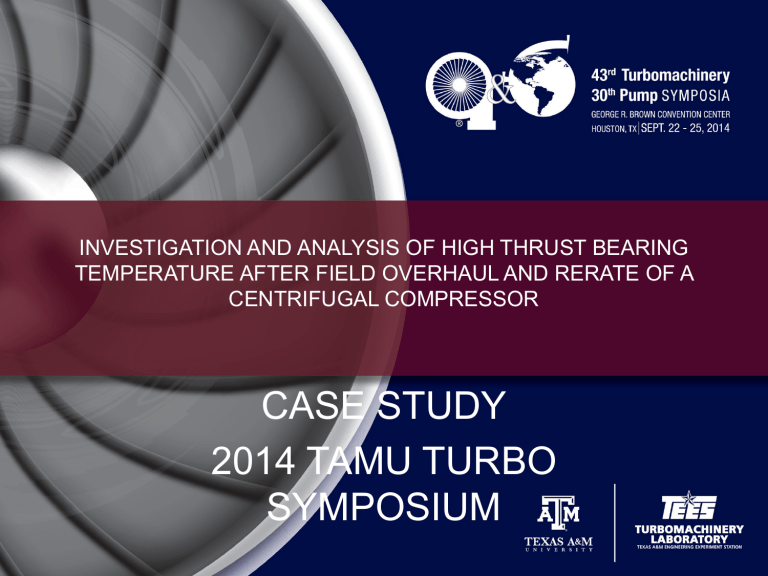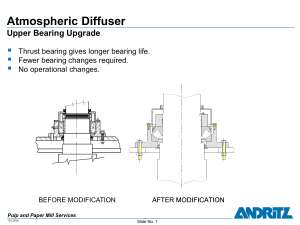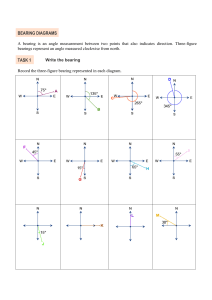
INVESTIGATION AND ANALYSIS OF HIGH THRUST BEARING TEMPERATURE AFTER FIELD OVERHAUL AND RERATE OF A CENTRIFUGAL COMPRESSOR CASE STUDY 2014 TAMU TURBO SYMPOSIUM Authors • Barry J. Blair is the Chief Engineer at Waukesha Bearings Corporation, headquartered in Pewaukee, Wisconsin (USA). Mr. Blair has overall responsibilities for research & development activities at Waukesha, including new products and overseeing the refinement of bearing design tools and methods. Mr. Blair joined Waukesha Bearings in 1993 and has served in increasingly responsible engineering and technology roles. Mr. Blair received both his Bachelor’s of Science (Mechanical Engineering, 1990) and Master’s of Science (Mechanical Engineering, 1990) from the University of Virginia, completing requirements of both degrees concurrently. Throughout his career he has authored and coauthored several papers on the development of both hydrodynamic and active magnetic bearing technologies. • James M. Byrne is currently a member of the BRG Machinery Consulting team. BRG performs research and analysis in the fields of fluid film bearings, magnetic bearings, and rotor dynamics as well as providing machinery specialist support to the oil and gas, aerospace, and power generation industries. He began his career designing internally geared centrifugal compressors for Carrier in Syracuse, NY. Mr. Byrne continued his career at Pratt and Whitney aircraft engines and became a technical leader for rotor dynamics. Later he became a program manager for Pratt and Whitney Power Systems managing the development of new gas turbine products. From 2001 to 2007, he was president of Rotating Machinery Technology, a manufacturer of tilting pad bearings. He holds a BSME degree from Syracuse University, an MSME degree from the University of Virginia, and an MBA from Carnegie Mellon University. • Stephen L. Ross is a Senior Consulting Engineer in the Technical Services group of Elliott Company in Jeannette, Pennsylvania. He has 34 years experience with centrifugal compressors and has been with Elliott Company for 28 years, working in compressor design and field service. He is a previous author for the 20th, 31st and 32nd Turbomachinery Symposia. Mr. Ross obtained a B.S. degree (Mechanical Engineering, 1980) from The Pennsylvania State University. He is a registered Professional Engineer in the State of Pennsylvania and a member of ASME. • Jonathan Toner is a machinery engineer with ExxonMobil Research & Engineering. He began his carrier with ExxonMobil in 2001. He has provided machinery engineering support for plant operations and projects at various polymer and olefin facilities in the gulf coast area. He earned his Bachelor of Science in Mechanical Engineering from Washington University in St. Louis. Abstract A centrifugal compressor in olefins plant charge gas service experienced excessive thrust bearing temperatures after startup following a field overhaul and rerate. While the machine was online, an analytical study was carried out to determine the possible causes for the excessive thrust bearing temperature. The study involved confirmation of the aero load through calculation, verifying the thrust bearing’s capacity with the use of computer modeling, and correlation with operating field data to determine the likely cause of thrust bearing distress. A mechanical test of an identical spare bearing was conducted on an existing thrust bearing test rig to confirm the results of the analytical study and field observations. A compressor outage was ultimately required to remedy the thrust bearing issue. A methodical approach to the shutdown work was employed to assure detection and correction of the cause for the thrust bearing distress while minimizing the duration of the plant outage. The approach included full scale oil flow rate testing in the field as well as a comprehensive bearing disassembly and inspection plan. The culprit for the excessive thrust bearing temperature was discovered and corrected allowing for successful compressor operation after restart. This case study examines non-intrusive analysis and test methods to understand the issue without the chance of repeated outages. Problem Statement • A centrifugal compressor in ethylene plant charge gas service experienced high thrust bearing temperatures after startup from an overhaul and rerate • The pad metal temperatures reached 265°F with a 40°F spread between instrumented pads • Pad metal temperature would have been higher, but compressor speed was limited to avoid exceeding 265°F limit • This speed limit imposed significant production losses. …At times limiting the plant to 75% of its nameplate capability Machine Background Information • High pressure casing of charge gas train – 30 khp 2 section, five stage, back to back, centrifugal compressor with unbalanced seals • Compressor rerated as part of a plant turn around – 1st section was rewheeled – Balance piston size increased – Retrofitted with dry gas seals • Thrust Bearing Design – 10-1/2”, 39 in2, self leveling, copper backed, offset pivot, flooded lube – Compressor design speed 4812 to 6400 rpm. – Same bearing as before rerate Initial Investigation: Analytical Analysis • First phase of trouble shooting involved analytical review of the design and of the baseline operating data – Full aero design review to confirm original design calculations – Operating tests involving varying speed, gas composition, and section discharge pressures were performed to determine operating envelope and collect operating data – Short term online mitigations: increased oil supply pressure, reduced oil supply temperature and (later) adding large oil coolers carried out while analysis was ongoing • Compressor OEM facilitated the aero load check – Thrust load was up 32% from pre to post rerate due to rerate configuration changes – Post rerate load should still be within the design capability of the bearing! – Off design operating conditions were also checked…none could generate enough load to distress the bearing Analytical Analysis--Continued • Modeling of the exact bearing design was performed by a machinery consulting company using proprietary 3D finite element solution to Reynolds equation with thermal and mechanical deformations, turbulent flows, full energy equation solution • Modeling results indicated the bearing temperature should be less than 200°F…IF PROPER OIL FLOW WAS APPLIED • Determined design oil flow was 20% lower than industry by comparison to similarly sized “catalog” bearings • Began to suspect oil flow as most likely cause of poor performance • Focused effort on preparing a retrofit directed lube bearing for the application that would require less oil to carry the same load How to Prove the Analytical Findings? • As the business could ill afford an improper diagnosis/fix, the question of “Are you sure?” had to be answered • An empirical test plan was devised to prove the analytical findings • The test plan involved utilizing a thrust bearing test rig to prove the conclusions derived in the analytical investigation Test Plan Strategy 1. Determine what questions can be answered by testing (not all can) 2. Need to mimic field installation exactly a) b) c) d) e) f) Same inlet and drain orifices Same inlet and drain size, shape, orientation Same TC wires, orientation, and routing Same thrust float Same thrust cavity design Same thrust collar design 3. Is there an inherent design problem with the bearing? 4. Study the bearing temperature sensitivity to: a) Load b) Oil flow 5. Confirm design oil flow using the same orifices and flow cavities Testing to Simulate Compressor on the Large Horizontal Thrust Rig Test Chamber Load Bearing (LHTR) Test Shaft Load Piston Maximum Pad Temperature Above Inlet (°F) Field Data for Baseline Comparison Maximum Measured TPT Temp. (Flow Unknown) 180 160 140 Difference in Pad Temperatures Spread 40 (°F) = 40 °F 120 100 80 60 Measured TPT Temperature Before Rerate 40 20 Estimated via modeling 0 0% 25% 50% 75% 100% 125% Flow Factor Measured Flow/Nominal Flow 150% Field Data Test Protocol Load Factor Applied Load/Nominal Load 300% Increase Load 250% 200% Decrease Flow 150% Increase Flow 100% 50% Baseline Decrease Load 0% 0% 25% 50% 75% 100% 125% Flow Factor Measured Flow/Nominal Flow 150% 180 160 Spread 40 Spread = (°F) 40 °F 140 120 21 (°F) Spread 21 °F Test Data 100 LoadFactor Factor = 264% Load = 264% Load Variation Maximum Pad Temperature Above Inlet (°F) Laboratory Test Data 80 60 9 (°F) 9 °F Spread 40 Baseline Prediction 20 0 0% 25% 50% 75% Load Factor==0% 0% Load Factor 100% 125% Flow Factor Measured Flow/Nominal Flow 150% Test Rig Results Implications • The original thrust bearing design is robust and suitable for the application parameters • A ‘feasible’ load does not cause temperatures as high as the ones measured in the field • A severe lack of oil, compared to design, can result in excessive pad temperatures – Possibilities: internal bypass, leak, or obstruction – Thrust cavity was no longer “flooded” resulting in a large pad temperature spread due to varying degrees of pad oil starvation around the bearing • Focus for the field troubleshooting effort should be placed on the oil supply to the thrust bearings Compressor Outage and Field Testing • The analytical and empirical results guided the repair plan development – Comprehensive disassembly checklists developed to search for oil flow limiting culprits – Oil flow testing performed before disassembly to capture baseline data and to compare with the test stand values – Oil flow measured again after resolution to confirm proper flow had been restored • Compressor ultimately taken offline due to degraded bearing performance after one year of operation—the outage plan was put into action Low Oil Flow Due to Orifice Position • Radial bearing metering orifice found in thrust position (15/64” compared to 27/64” design) These orifices were swapped Radial orifice • Suspect pipe plug orifices were swapped when rebuilding during turn around overhaul • Field oil flow testing matched test stand data, confirming root cause Thrust orifice • Post rebuild oil flow test confirmed that design flow had been restored to the radial bearing and had been properly applied to the retrofitted directed lube bearing Bearing damage • Most severe damage to pads in region of the “hottest oil” in farthest clock position from oil the inlet • Babbitt delamination noted • Likely compounded performance problem, especially at late stages of the run • Inactive bearing was pristine Summary • A centrifugal compressor suffered from excessive thrust bearing temperature after startup from a field overhaul rerate • Analytical analysis suggested the problem was due to insufficient oil flow • Empirical testing confirmed low oil flow theory, but showed that deficiency was much more severe than first thought • Using the investigation results, a comprehensive plan was developed to target the oil flow problem during the compressor downtime • The root cause, swapped metering orifices, was found and corrected • The machine was successfully restarted and run without issue Lessons Learned • Collaboration was key to resolving the thrust bearing issue – Compressor OEM, end user, bearing design company with test stand and testing expertise, and a machinery design consulting company with bearing modeling expertise were all critical to the solution – Open communication and data sharing amongst all parties was critical • Complex problems require advanced techniques to resolve…cannot be afraid to ask for and seek out resources • No detail of a new fabrication/overhaul/rebuild is too small to check – Level of oversight should be based on the impact of equipment downtime…sometimes difficult when considering business pressures to speed turn around time, which causes a reduction of audit detail level – Can consider flow testing individual components, assemblies, or complete units in a shop setting to prove proper operation…common in aerospace industry – Similarly, it is possible to efficiently flow test complete assemblies in the field to prove system viability with some basic pre-planning Lessons Learned • Designs should be “mistake proofed” as much as possible – Ensure different parts cannot be installed in the wrong place – Separate oil supply lines for journal and thrust cavities with external metering orifices can minimize chance of mix ups – Also common design practices in the aerospace industry • Study of this problem revealed the general robustness of design of the thrust bearing for this API compressor – Analysis and testing proved that a severe mechanical deficiency was required to produce the excessive temperatures measured – The bearing could tolerate significant overload and reduced oil flow as compared to rated design


